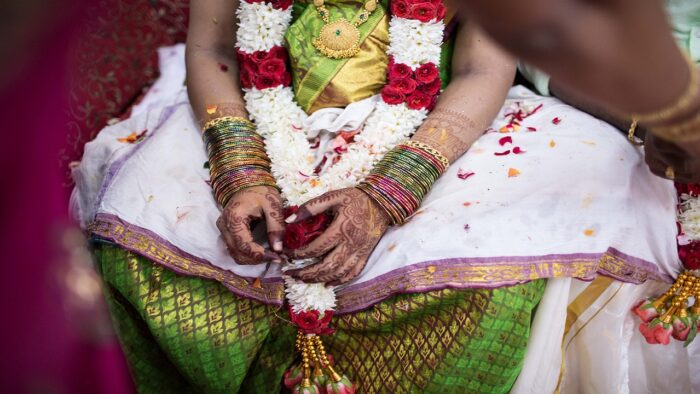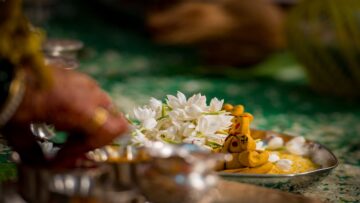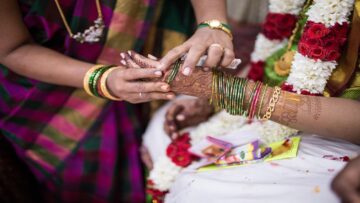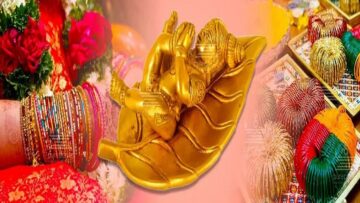Puṃsavana is often explained as a ritual to get a male child. However, Pumsavana is a rich multifaceted ritual, whose other aspects have been ignored. This article aims to delve into the broader aspects of Pumsavana by examining the Śāstras on Puṃsavana.
Statistics from various sources report that around one to two out of every ten pregnancies ends up in a miscarriage. Miscarriage is not a simple matter – it can leave a couple, especially the woman with a range of emotions and lots of questions. It may also affect consecutive pregnancies as well. According to the Jyotiṣa, some women are bound to have trouble related to childbirth due to certain planetary positions. Because of this, many of our Ṛṣis prescribed the Garbhādhāna ritual as a prophylaxis, as well as the Puṃsavana ritual in three different forms, to safeguard a pregnant lady.
Saṃskāras such as the Pumsavana play a key role in the preservation of our culture within the upcoming generation, and the safeguarding of Bhārata.
A few terms –
Garbhādhāna = Garbha + ādhāna. Garbha = Fertilisation or fusion of the male and female energies or cells. Ādhāna = Deposition/Establishment. In this context, it means ‘Impregnation’ done with the chanting of mantras or ślokas for procreation to maintain the family’s legacy. Garbhādhāna is the first Saṃskāra among the Sixteen Saṃskāras for an individual that is to be mandatorily performed for a Dharmic progeny.
Saṃskāra= A ceremony prescribed by our Śāstras for enhancing one’s good conduct and skill, it is beneficial for both the Ātmā and body.
Śruti= A synonym for ‘Veda’.
Smṛti = A synonym for ‘Śāstra’.
Vrata = A set of rituals that is to be done on a particular day or days with dietary restrictions.
Karma = Any action or deed (can be a bit of dietary advice or a prescribed method or some activity; this is explained like this for ‘Puṃsavana’ here).
PañcaBhūtas = Ākāśa (Space), Vāyu (Air), Agni (Fire), Āpaḥ (Water), and Pṛthvī (Earth) – in simpler terms, the five elements.
Puṃsavana = A protocol with certain guidelines to beget a healthy child, it can be explained with the below three variations.
Puṃsavana Saṃskāra = A ritual that must be done for each pregnancy with Vedic or Purāṇic mantras. One important aspect of this ritual involves the procedure called Nasya and this Nasya is a commonly used Āyurvedic treatment method where medicine is administered through the nostrils.
Puṃsavana Karma = The methods or diet or medicines prescribed in Āyurveda and other Śāstric texts. Certain methods described here help in conception also.
PuṃsavanaVrata = A Vrata mentioned in ŚrīmadBhāgavatathat ensures overall welfare for the mother and the children. (The Saṃskāra is done only once whereas the Karma and Vrata can be done any number of times.)
Ādhyātmic= Anything related to the Ātmā or spiritual.
The three Puṃsavanas
Puṃsavana is often explained as a ritual to get a male child. But is Puṃsavana solely preoccupied with begetting a male child? Let us apply the GuṇopasaṃhāraNyāya[1] once again. The health aspects of this Puṃsavana are not to be taken lightly.
Puṃsavana can be divided into three aspects –
- Puṃsavana Saṃskāra
- Puṃsavana Karma
- Puṃsavana Vrata
All three kinds of Puṃsavana in general are mainly done to prevent any (anatomical, morphological, psychological or Ādhyātmic) defects in the foetus.
Puṃsavana = Pum + savana
Pum = Male or female. (Just like Putra, ‘Pum’ denotes both).
Savana = offering or ritual.
Puṃsavana= A ritual for successfully bringing forth a child.
The Saṃskāras deal with many aspects of the child’s health, and one such aspect is to ensure that a child is born and lives healthily. Not just congenital anomalies but other health ailments could be prophylactically addressed by complementing modern science with this traditional ritual.
Objectives of Puṃsavana
In the present day, childbirth without any hassle has become a huge achievement. Health is our primary concern, and Dalhana (an eminent physician who lived centuries ago) has given his opinion about Puṃsavana’s objectives –
- Achievement of proper conception after Maithuna (sexual intercourse).
- Ensuring good health for the baby till birth.
- Selection of the baby’s gender.[2]
Śrīmad Bhāgavata on the benefits of Puṃsavana (Vrata) –
मृतप्रजाजीवसुताधनेश्वरीसुदुर्भगासुभगारूपमग्र्यम् ॥26 ॥[3]
मृतप्रजा = Unsuccessful pregnancy or a baby dying shortly after birth.
सुदुर्भगा = Very unlucky or miserable.
According to the Śrīmad Bhāgavata Purāṇa, women who follow the Pumsavana ritual will obtain long-lived children, and she along with her spouse and her children will become prosperous and beautiful.
Gender Selection and Puṃsavana
SivanSir[4] has explained that changing gender requires great penance.[5]
One of the rituals of Puṃsavana Saṃskāra involves administering nasal drops to the mother (a procedure called Nasya). (This will be explained later.). Administering nasal drops to the right nostril may bestow a boy and (Vāma) the left nostril may bestow a girl.
Nowadays, this Saṃskāra happens only in a few families at the proper time, and it is always in the right nostril (as Smṛtis mention only the right nostril). Even in those families, females are being born. Smṛtis mention only the right nostril, the reason could be –
- Always, any karma starts with the right side of the body in most of the rituals. For example, the right foot must be kept first, or the right eye is touched first. So, the right nostril could have been mentioned keeping these in mind. Please do not administer nasal drops in the left nostril during the Puṃsavana Saṃskāra of the first pregnancy itself. (It can be done for consecutive ones if one desires.)
- A couple having children of both genders is considered fortunate, but usually the first child being a male is taken as a good sign. (The right nostril is not a guarantee for a male child, please remember this.)
- If the parents are destined to get only girls or only boys, nothing much can be done. The family has to accept the reality. For example, some couples may be destined to get a daughter only after begetting four sons or vice versa, the parents’ health and the overall situation must be taken into consideration.
People get scammed by many things, especially when it comes to the procreation of male babies; please consider Puṃsavana as a tool for a baby’s proper growth rather than gender selection. The Ṛṣis who have described Puṃsavana say that the gender selection factor is primarily determined by our past and present deeds.[6]
If you take something like deciding the gender of a baby, the possibility is determined by multiple factors (which are impossible to control) and Puṃsavana alone is not the determining factor.
There are many Śāstras that discuss the determination of a child’s birth. A couple must not be burdened in matters of procreation and if they wish to have the desired gender, let them leave the matter to Bhagavān with a simple prayer.
It takes many Janmas (liftetimes or births) of effort to achieve such an ability as deciding or changing the gender of a fetus (and such a qualified person is usually a Devatā or a Ṛṣi).
The importance of the time and place
अविरुद्धे ध्रुवं दैवे काले युक्तस्य कर्मणः ।
सिद्धिः पुंसवनाद्यस्मात् पूर्वं व्यक्तेः प्रयोजयेत् ॥AṣṭāṅgaSaṅgrahaŚārīraSthāna-2/41
For getting successful results we need to do the required thing at the appropriate time (with both the human effort and Devatā Anugraha through Pañcāṅga). Likewise, Puṃsavana Saṃskāra must be done as soon as the signs of pregnancy are confirmed to attain the maximum results. The details regarding the time will be discussed later.
Benefits of our Saṃskāras
जाताश्चैवं रूपवन्तो महासत्त्वाश्चिरायुषः ।
ऋणान्मोचयितारः स्युः सुपुत्राः पुत्रिणां मताः ॥ AṣṭāṅgaSaṅgrahaŚārīraSthāna-2/42
The ones who had procreated skilled children[7] (by personal experience) say that the children who are raised by regular performance of the Saṃskāras will be bestowed with good physical appearance, greater intellect, and a long lifespan.
Such children will undoubtedly relieve their parents of their debts (the debts to Devātas, Ṛṣis, and Pitṛs).This śloka is also an example of a documentation made of the beneficial effects of these Saṃskāras:
मुखं दृष्ट्वा तु पुत्रस्य मुच्यते पैतृकादृणात् ॥
पौत्रस्य दर्शनाज्जन्तुर्मुच्यते चः ऋणत्रयात् ।
लोकानन्त्यं दिवः प्राप्तिः पुत्रपौत्र-प्रपौत्रकैः ॥
GaruḍaPurāṇa -Pretakāṇḍaḥ (Dharmakāṇḍaḥ) – Adhyāyaḥ – 2.24/33-34
A person is relieved from the debt to Pitṛs by looking at his/her child’s face.
All three debts are relieved by looking at the face of his/her grandchild.
By looking at the face of the great-grandchild, mokṣa and everlasting happiness are granted.
देवताचारशौचादिरता सूते महागुणम् ।
धावत्येवं चाचरितं प्राग्जन्माभ्यासयोगतः ॥AṣṭāṅgaSaṅgrahaŚārīraSthāna-2/43
The parents (right from childhood) who regularly worship the Devatās following the regulations of the Śāstras and Ācāra[8] will beget children bestowed with extraordinary skills and benevolent nature. These habits will make Puṇya karmas (meritorious deeds) of the parents’ past lives manifest in their children.
We must not forget that Puṃsavana plays a role in the mother’s and child’s health and in preventing fatalities. So, this must be put into application in one’s life without deviations.
… To be continued.
References
[1](Nyāya = rule. This rule states that one must assess all available information from many reliable sources to arrive at a conclusion for a specific question.) Explained with an example in Part 2 – Garbhādhāna.
[2]SuśrutaSaṃhitāŚārīraSthānam 2/32 – Dalhana’sTeeka
[3]ŚrīmadbhāgavataPurāṇa -Skandhaḥ 6 – Adhyāyaḥ 19
[4]A SiddhaPuruṣa, the Pūrvāśrama younger brother of MahāPeriyavā. Also known as BrahmaśrīSadāśivaŚāstrīgal.
[5]Only a person of extraordinary Tapo Bala is capable of such a feat.YennipadigalilMaandhargal Pg 28, 17 (G).
[6]AṣṭāṅgaSaṅgrahaŚārīraSthāna 1/60, AṣṭāṅgaHṛdayaŚārīraSthāna 1/37
[7]One who fulfills and protects the legacy of one’s lineage is ‘Putra’, this applies to both males and females.
[8]Ācāra = good conduct and not just cleanliness
Feature Image Credit: istockphoto.com
Disclaimer: The opinions expressed in this article belong to the author. Indic Today is neither responsible nor liable for the accuracy, completeness, suitability, or validity of any information in the article.











